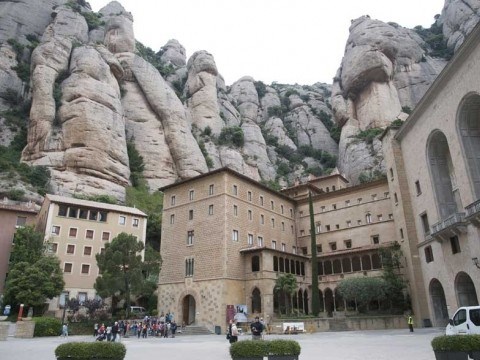On of the most impressive wineries in the world is about an hour's drive from Barcelona. Here the Torres family operates 15 distinct vineyards - some are celebrated "single" vineyards of a particular grape - on 1,300 hectares, extending from the Penedes Mountains, down through a series of stepped plateaus, to the Mediterranean coast.
The Torres family has been producing wine here since 1800; the current baron is Miguel Torres. Torres runs a kind of empire, exporting wine and some spirits to 120 countries. As well as this vast spread in Spanish Catalonia, the family owns thousands of wine-producing hectares in Chile and California.
At B.C. liquor stores you can pay between $14.50 and $65 for Torres wines, the latter being a cabernet sauvignon from its Catalonian Mas La Plana vineyard. In 1970, Torres shook up the wine world when one of these Mas La Plana cab-sauvs beat out all its competitors at a kind of wine Olympiad in France. Since then it's been, well, nothing but up. At the same time, Torres has enhanced its reputation by pioneering conservation and environmental issues in Spain and abroad, even at the loss of major grape yields.
At Torres, a mini-train ride takes visitors through lower-level vineyards and a tunnel that, with a multi-media presentation, replicates the year-round life of the estate. Our winery host, Lluis Canellas (despite his name, he's French: "In Spain they tell me it's my one flaw," he laughed), took us through tastings that included a gewürztraminer, chardonnay, cabernet sauvignon, merlot and others. Near the end of our visit (by now the conversation was pretty spirited), Canellas disappeared, eventually returning with a particularly superior vintage of the Mas La Plana. I haven't forgotten it.
From the higher reaches of the Torres estate, you can see a series of rounded sandstone spires standing alone on the plain. This is Montserrat (meaning "serrated mountain"), an important symbol and place of pilgrimage for Catalonian Spaniards.
It's an hour drive northwest from Torres to Montserrat. Up close the mountains look otherworldly, like bulbous pillars. For that reason, and the presence of crevices and caves, these mountains attracted hermits. An image of Mary is said to have been found in a cave in 880 AD. A Benedictine monastery began to take shape a century later.
Today Montserrat remains a functioning monastery with a world-famous boys' choir. It's also an impressive architectural site, reached by a funicular railway. As well, it's the base for trails and climbs to remote caves and chapels.
On the monastery level, 750 metres above sea level, with spectacular views over the plain, stands a large complex, including hotel and restaurants. An exceptional gallery features works of Impressionists and Expressionists including Picasso and Dali, but as importantly, paintings by significant but less widely known Catalan modernists - artists with names like Rusinol, Casas, Nonell and Mir.
Started in the 16 th century, the basilica was pretty much destroyed during the Napoleonic wars. Rebuilt at the end of the 19 th century, it is today an odd blend of gothic, Byzantine, renaissance, and modernist Catalan design. This shrine-church is made up of a huge single nave and buttresses, innumerable side chapels, and a separate and sumptuous throne room that houses the revered image of Mary.
From the statues above the entrance, to the octagonal interior dome, through one-of-a-kind votive lamps, carved wood pillars and contemporary, even avant-garde, religious art, everything is the work of the most skilled and gifted Catalonian artists and artisans. Clearly a great deal of money - and passion - has gone into this basilica. In a way it can be seen as modern - and people friendly. Cumulatively, it's awesome.
Among the great Catalan architects who worked on Montserrat was a friend and colleague of Antonio Gaudi, Josep Puig i Cadafalch. Puig designed the plazas that lead into the basilica. And back down on the plain, not far from the Torres estate, he created the main building of the Codornui Winery, one of the largest makers of the sparking white Spanish wine called cava.
Huge wrought-iron gates open onto this red-brick winery shaped like a series of parabolic arches, with windows of stained glass. The impression is both appropriately earthy (this being a winery) and suggestive of Montserrat, still a central feature of this Penedes region (and lovingly guarded by Catalonia during the Spanish Civil War).
Codornui introduced cava to Spain in the late 1800s. So it's the oldest cava producer, though not the largest (that honorific goes to nearby Freixenet). Similar to Champagne, cava is fermented with a wine base before sugar is added. It's then blended, fermented again, and stored upside down. Codornui sells 50 million bottles a year, with another 100 million fermenting in its cellars. You can buy a bottle of cava for about $5, and a good one for $10. An excellent bottle can be had for, say, $50 - "less than a comparable bottle of champagne," says Codornui staffer Asier Vivanco Larrea.
As at Torres, a "train" carries visitors through several of the 26 kilometres of darkened subterranean cellars. Afterwards, pourers like Larrea, a young Basque cava expert, will introduce you to cavas like Codornui's Pinot Noir and the Codornui Clasico.
You can find cava, often accompanied by a plate of cheese and olives, anywhere in Spain. But the place to really enjoy this beverage is in its birthplace, here in Catalonia, within an easy drive of the grape-growing Penedes and the mountains of Montserrat.




